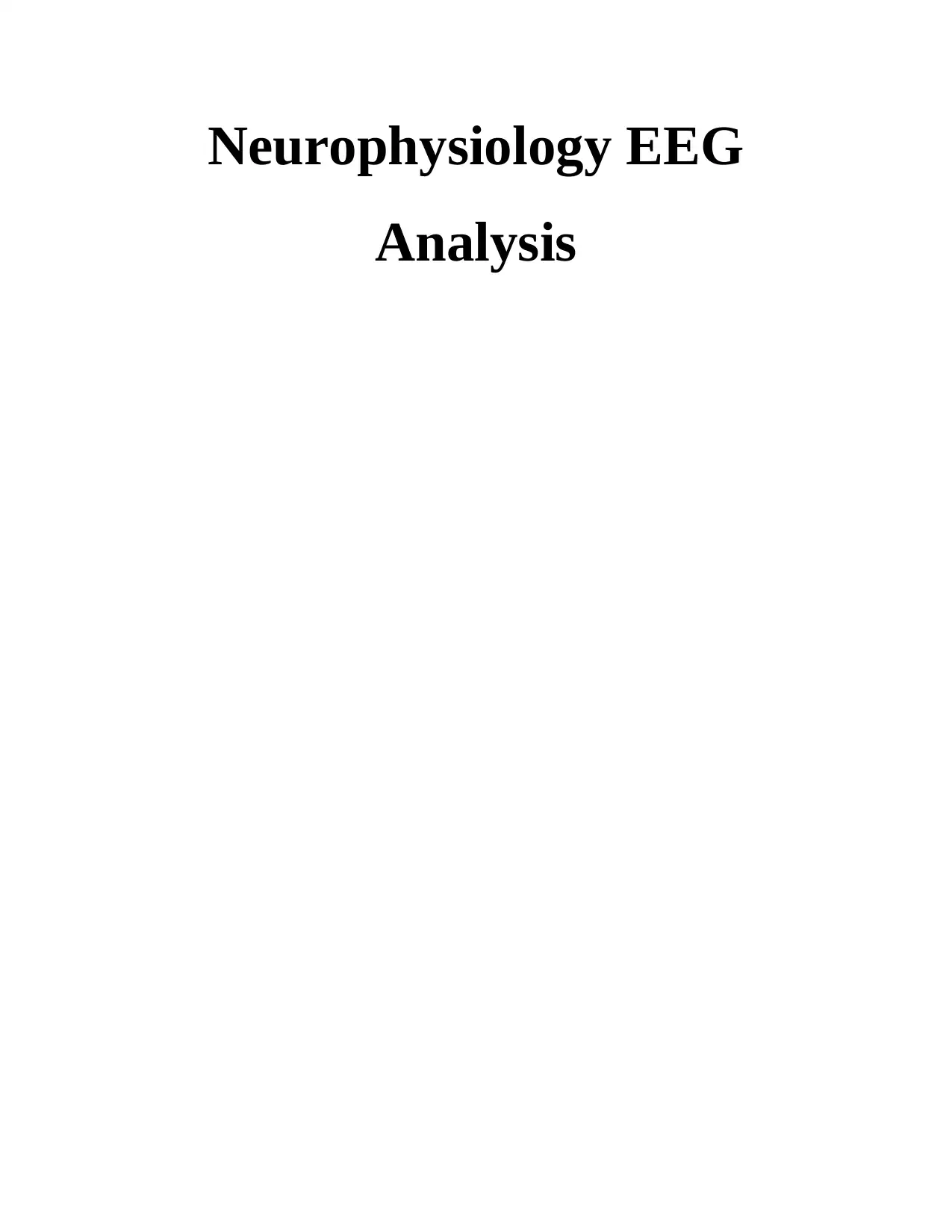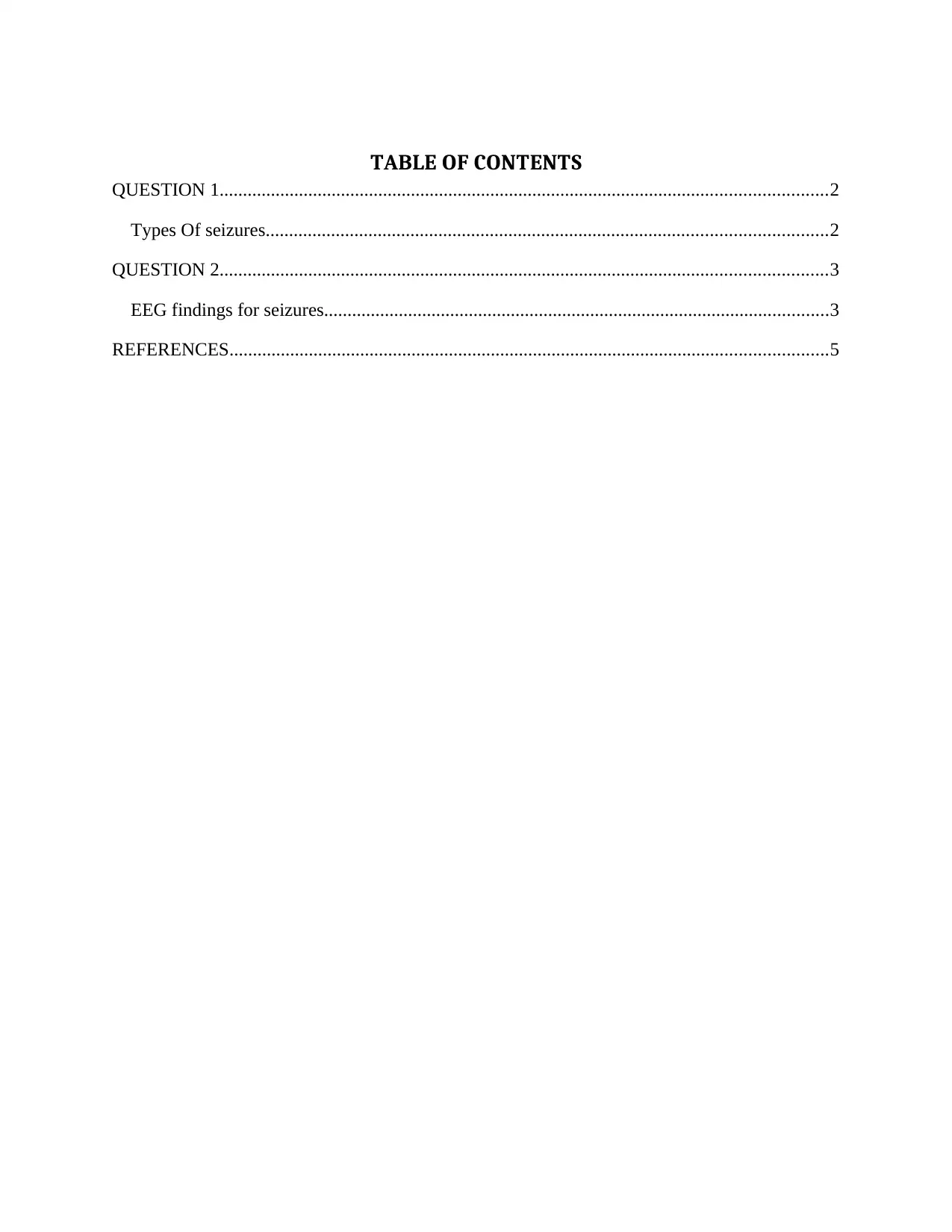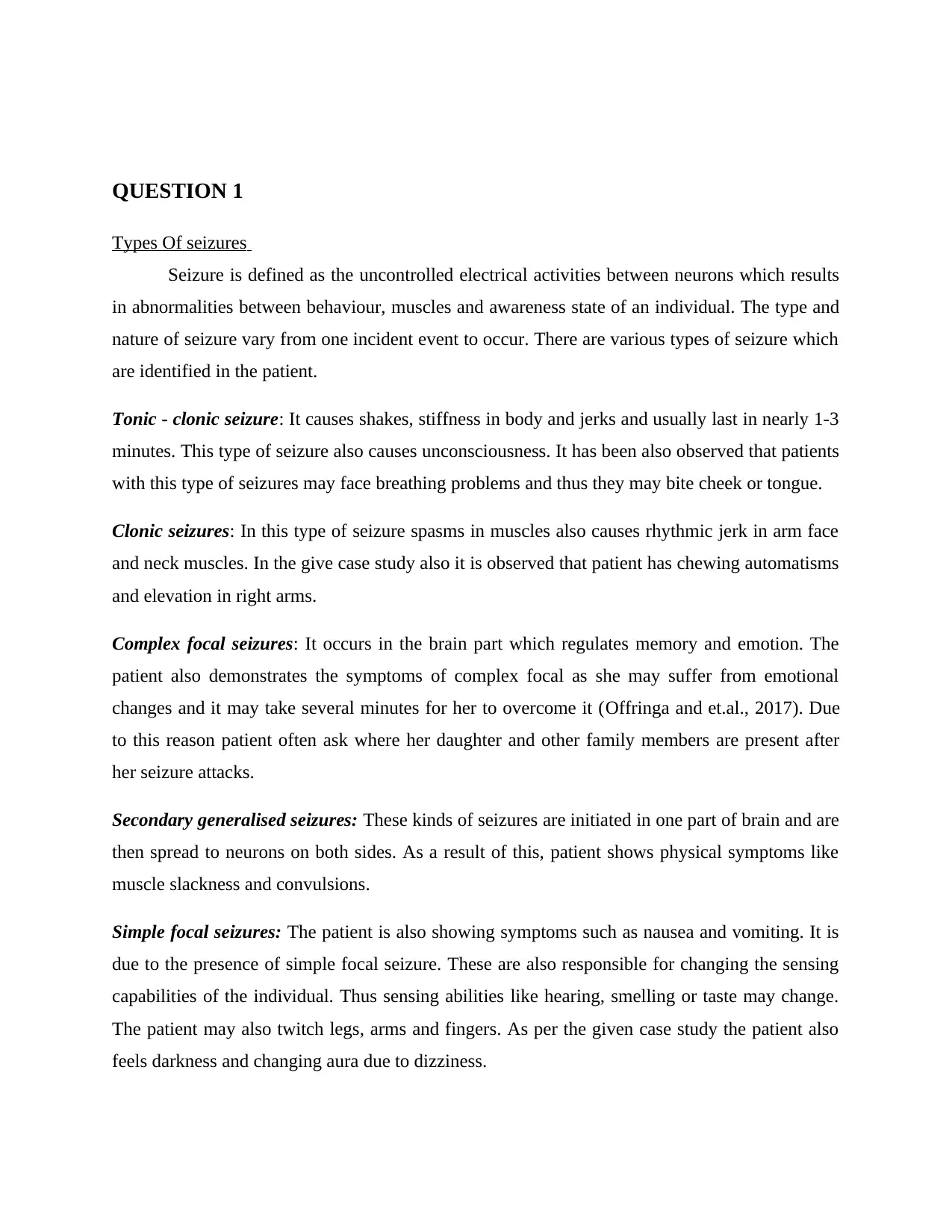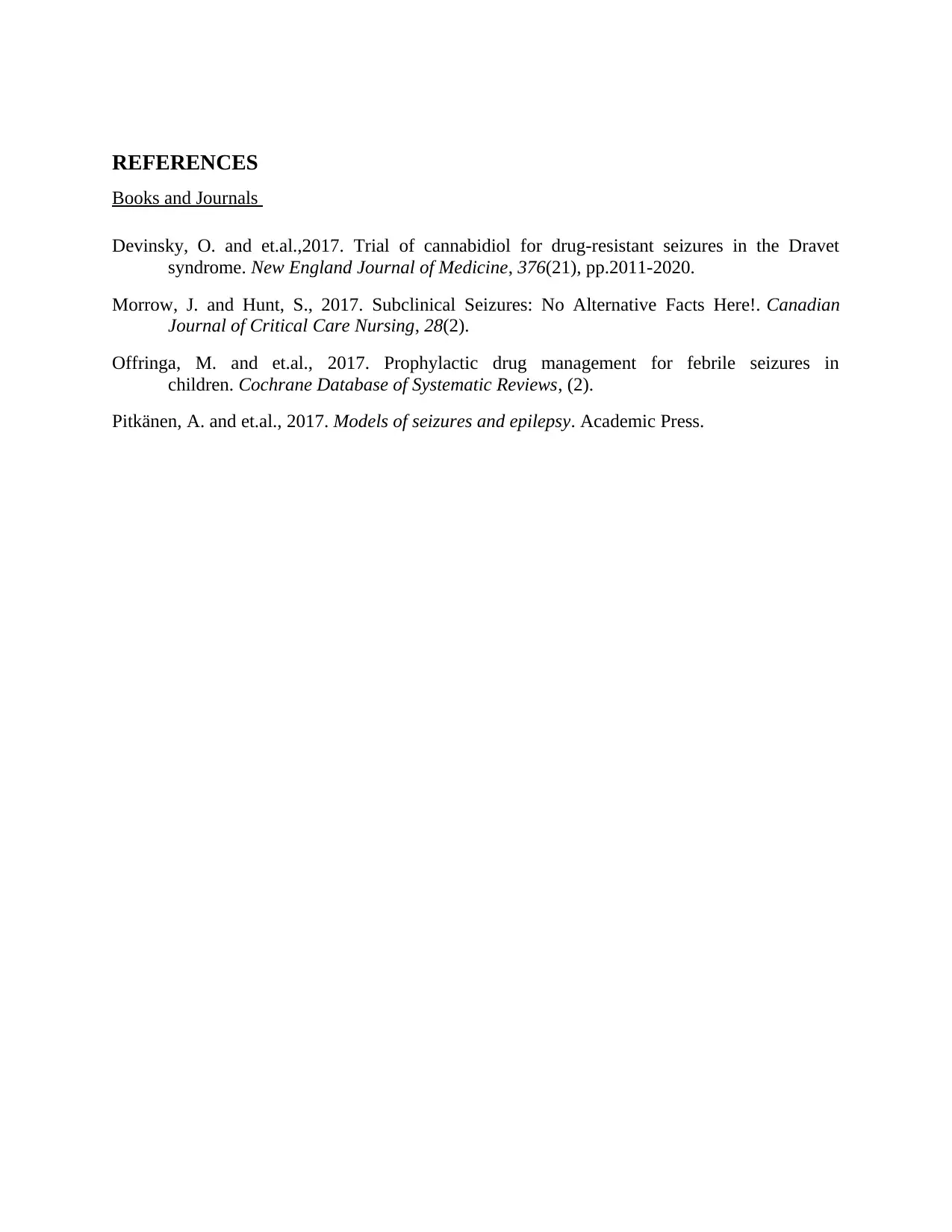Neurophysiology Report: EEG Analysis of Seizure Types and Findings
VerifiedAdded on 2023/01/11
|6
|1078
|33
Report
AI Summary
This report presents an analysis of electroencephalogram (EEG) findings in the context of neurophysiology, focusing on the identification and differentiation of various seizure types. The report begins by defining seizures and categorizing them into distinct types, including tonic-clonic, clonic, complex f...

Neurophysiology EEG
Analysis
Analysis
Paraphrase This Document
Need a fresh take? Get an instant paraphrase of this document with our AI Paraphraser

TABLE OF CONTENTS
QUESTION 1..................................................................................................................................2
Types Of seizures........................................................................................................................2
QUESTION 2..................................................................................................................................3
EEG findings for seizures............................................................................................................3
REFERENCES................................................................................................................................5
QUESTION 1..................................................................................................................................2
Types Of seizures........................................................................................................................2
QUESTION 2..................................................................................................................................3
EEG findings for seizures............................................................................................................3
REFERENCES................................................................................................................................5

QUESTION 1
Types Of seizures
Seizure is defined as the uncontrolled electrical activities between neurons which results
in abnormalities between behaviour, muscles and awareness state of an individual. The type and
nature of seizure vary from one incident event to occur. There are various types of seizure which
are identified in the patient.
Tonic - clonic seizure: It causes shakes, stiffness in body and jerks and usually last in nearly 1-3
minutes. This type of seizure also causes unconsciousness. It has been also observed that patients
with this type of seizures may face breathing problems and thus they may bite cheek or tongue.
Clonic seizures: In this type of seizure spasms in muscles also causes rhythmic jerk in arm face
and neck muscles. In the give case study also it is observed that patient has chewing automatisms
and elevation in right arms.
Complex focal seizures: It occurs in the brain part which regulates memory and emotion. The
patient also demonstrates the symptoms of complex focal as she may suffer from emotional
changes and it may take several minutes for her to overcome it (Offringa and et.al., 2017). Due
to this reason patient often ask where her daughter and other family members are present after
her seizure attacks.
Secondary generalised seizures: These kinds of seizures are initiated in one part of brain and are
then spread to neurons on both sides. As a result of this, patient shows physical symptoms like
muscle slackness and convulsions.
Simple focal seizures: The patient is also showing symptoms such as nausea and vomiting. It is
due to the presence of simple focal seizure. These are also responsible for changing the sensing
capabilities of the individual. Thus sensing abilities like hearing, smelling or taste may change.
The patient may also twitch legs, arms and fingers. As per the given case study the patient also
feels darkness and changing aura due to dizziness.
Types Of seizures
Seizure is defined as the uncontrolled electrical activities between neurons which results
in abnormalities between behaviour, muscles and awareness state of an individual. The type and
nature of seizure vary from one incident event to occur. There are various types of seizure which
are identified in the patient.
Tonic - clonic seizure: It causes shakes, stiffness in body and jerks and usually last in nearly 1-3
minutes. This type of seizure also causes unconsciousness. It has been also observed that patients
with this type of seizures may face breathing problems and thus they may bite cheek or tongue.
Clonic seizures: In this type of seizure spasms in muscles also causes rhythmic jerk in arm face
and neck muscles. In the give case study also it is observed that patient has chewing automatisms
and elevation in right arms.
Complex focal seizures: It occurs in the brain part which regulates memory and emotion. The
patient also demonstrates the symptoms of complex focal as she may suffer from emotional
changes and it may take several minutes for her to overcome it (Offringa and et.al., 2017). Due
to this reason patient often ask where her daughter and other family members are present after
her seizure attacks.
Secondary generalised seizures: These kinds of seizures are initiated in one part of brain and are
then spread to neurons on both sides. As a result of this, patient shows physical symptoms like
muscle slackness and convulsions.
Simple focal seizures: The patient is also showing symptoms such as nausea and vomiting. It is
due to the presence of simple focal seizure. These are also responsible for changing the sensing
capabilities of the individual. Thus sensing abilities like hearing, smelling or taste may change.
The patient may also twitch legs, arms and fingers. As per the given case study the patient also
feels darkness and changing aura due to dizziness.
⊘ This is a preview!⊘
Do you want full access?
Subscribe today to unlock all pages.

Trusted by 1+ million students worldwide

Tonic and atomic seizures: The patients who have intellectual disability and brain injuries often
suffer from tonic seizures. It results in sudden stiffness in body and injuries or falls. It is also
accompanied by Lennox Gastaut syndrome involving intellectual disability.
QUESTION 2
EEG findings for seizures
An electroencephalogram abbreviated as EEG is known as the non-invasive test method
which is used for recording electrical patterns in brain. The test is very helpful in diagnosing
conditions such as seizures and epilepsy and headaches. EEG demonstrates abnormal activities
in brain so that focal and generalised seizures can be distinguished. In situations when these
abnormalities are not detected then it also possible that epilepsy is still present and there may be
need of video EEG or ambulatory monitoring. In EEG the recordings are taken from the four
regions of brain namely frontal lobe, temporal lobe, parietal and occipital lobe. Frontal lobes
readings are helpful to detect the abnormalities in voluntary movements, speech, learning and
consciousness (Morrow and Hunt, 2017). The side areas of brain or temporal lobe analyses the
impact of seizures on emotional and memory related changes. Thus many times their
involvement can also be seen in perception, hearing or speech. Other leads or electrodes are also
placed on parietal lobe which is known as the area at top of head so that sensations and feelings
of patient can be analysed. In addition to these occipital lobes are present at backside of head and
have responsibility for sight sensing and visionary functions.
In case of focal seizures the brain activity changes are observed on electrodes which are
placed on part of brain in which seizures are taking place. The electrode readings from other
parts of brain remain normal. Seizures does not have any specific or particular pattern on EEG, it
merely causes change in the brain activity records (Devinsky and et.al.,2017). Patient with tonic
and atomic seizures along with Lennox Gastaut syndrome shows distinctive pattern of slow
waves and spike in EEG. The EEG of patient also show spike wave which are persistent which at
deeper level of sleep become more prominent. In terms of polarity these spikes are often
considered as negative. With the presence of seizures mid temporal or anterior interracial spikes
are also observed with 5-7 ictal discharge. In certain cases patient may also show poly-spike
discharge with frequency of greater than 3 Hz. It also runs occipital rhythmic data. The
suffer from tonic seizures. It results in sudden stiffness in body and injuries or falls. It is also
accompanied by Lennox Gastaut syndrome involving intellectual disability.
QUESTION 2
EEG findings for seizures
An electroencephalogram abbreviated as EEG is known as the non-invasive test method
which is used for recording electrical patterns in brain. The test is very helpful in diagnosing
conditions such as seizures and epilepsy and headaches. EEG demonstrates abnormal activities
in brain so that focal and generalised seizures can be distinguished. In situations when these
abnormalities are not detected then it also possible that epilepsy is still present and there may be
need of video EEG or ambulatory monitoring. In EEG the recordings are taken from the four
regions of brain namely frontal lobe, temporal lobe, parietal and occipital lobe. Frontal lobes
readings are helpful to detect the abnormalities in voluntary movements, speech, learning and
consciousness (Morrow and Hunt, 2017). The side areas of brain or temporal lobe analyses the
impact of seizures on emotional and memory related changes. Thus many times their
involvement can also be seen in perception, hearing or speech. Other leads or electrodes are also
placed on parietal lobe which is known as the area at top of head so that sensations and feelings
of patient can be analysed. In addition to these occipital lobes are present at backside of head and
have responsibility for sight sensing and visionary functions.
In case of focal seizures the brain activity changes are observed on electrodes which are
placed on part of brain in which seizures are taking place. The electrode readings from other
parts of brain remain normal. Seizures does not have any specific or particular pattern on EEG, it
merely causes change in the brain activity records (Devinsky and et.al.,2017). Patient with tonic
and atomic seizures along with Lennox Gastaut syndrome shows distinctive pattern of slow
waves and spike in EEG. The EEG of patient also show spike wave which are persistent which at
deeper level of sleep become more prominent. In terms of polarity these spikes are often
considered as negative. With the presence of seizures mid temporal or anterior interracial spikes
are also observed with 5-7 ictal discharge. In certain cases patient may also show poly-spike
discharge with frequency of greater than 3 Hz. It also runs occipital rhythmic data. The
Paraphrase This Document
Need a fresh take? Get an instant paraphrase of this document with our AI Paraphraser

waveforms are also observed with the multiple phases and baseline crossing along with the after
going slow wave discharge which disrupt the continuation of background rhythms for few
moment. The patient also had childhood epilepsy and thus it is also possible that central temporal
spikes may also be observed. The EEG hallmark in such situations will have focal sharp wave
with high amplitude discharge in temporal and central regions. Sometimes the occipital spike
waves, striking discharge amount and rolandic spikes are also evident (Pitkänen and et.al., 2017).
The variations such as wicket spike 6 Hz and 14 Hz, subclinical rhythmic discharge, phatom
spike is also interpreted as the abnormalities in the readings of EEG. For distinguishing between
spikes and small sharp spikes short duration and amplitude is take as the base criteria.
Psychomotor variant does not have any frequency and differs from seizures discharge.
going slow wave discharge which disrupt the continuation of background rhythms for few
moment. The patient also had childhood epilepsy and thus it is also possible that central temporal
spikes may also be observed. The EEG hallmark in such situations will have focal sharp wave
with high amplitude discharge in temporal and central regions. Sometimes the occipital spike
waves, striking discharge amount and rolandic spikes are also evident (Pitkänen and et.al., 2017).
The variations such as wicket spike 6 Hz and 14 Hz, subclinical rhythmic discharge, phatom
spike is also interpreted as the abnormalities in the readings of EEG. For distinguishing between
spikes and small sharp spikes short duration and amplitude is take as the base criteria.
Psychomotor variant does not have any frequency and differs from seizures discharge.

REFERENCES
Books and Journals
Devinsky, O. and et.al.,2017. Trial of cannabidiol for drug-resistant seizures in the Dravet
syndrome. New England Journal of Medicine, 376(21), pp.2011-2020.
Morrow, J. and Hunt, S., 2017. Subclinical Seizures: No Alternative Facts Here!. Canadian
Journal of Critical Care Nursing, 28(2).
Offringa, M. and et.al., 2017. Prophylactic drug management for febrile seizures in
children. Cochrane Database of Systematic Reviews, (2).
Pitkänen, A. and et.al., 2017. Models of seizures and epilepsy. Academic Press.
Books and Journals
Devinsky, O. and et.al.,2017. Trial of cannabidiol for drug-resistant seizures in the Dravet
syndrome. New England Journal of Medicine, 376(21), pp.2011-2020.
Morrow, J. and Hunt, S., 2017. Subclinical Seizures: No Alternative Facts Here!. Canadian
Journal of Critical Care Nursing, 28(2).
Offringa, M. and et.al., 2017. Prophylactic drug management for febrile seizures in
children. Cochrane Database of Systematic Reviews, (2).
Pitkänen, A. and et.al., 2017. Models of seizures and epilepsy. Academic Press.
⊘ This is a preview!⊘
Do you want full access?
Subscribe today to unlock all pages.

Trusted by 1+ million students worldwide
1 out of 6
Your All-in-One AI-Powered Toolkit for Academic Success.
+13062052269
info@desklib.com
Available 24*7 on WhatsApp / Email
![[object Object]](/_next/static/media/star-bottom.7253800d.svg)
Unlock your academic potential
© 2024 | Zucol Services PVT LTD | All rights reserved.


